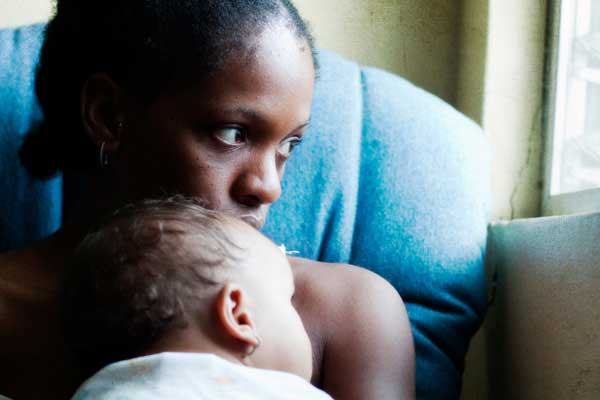What is Lucia? Stages and differences with periods

What is Lucia?
Lucia is a combination of amniotic fluid, tissue and blood that occurs naturally. In fact, Lucia is a natural fluid that is excreted vaginally after childbirth. This is important for removing excess blood and discharge from the uterus after delivery. The blood comes mainly from the area where the placenta separates from the wall of the uterus, leaving a wound that needs to be healed. The endometrial lining, which thickens during pregnancy, will be released in a similar way to menstruation.
During the nine months of pregnancy, the uterus forms a thick covering for the baby to feed and grow. The material inside the lining must be emptied after delivery to return the uterus to a non-pregnant state. This bleeding happens to any mother, whether their baby was born naturally or by cesarean section. Expect Lucia to last at least a month. Lucia will last up to 4 to 6 weeks, although more than 10% of women will experience bleeding for more than 40 days.
Sometimes menstrual cramps or small contractions can occur with Lucia, especially if you are breastfeeding. Breastfeeding helps the uterus to contract normally. Bleeding can be severe immediately after birth, so use absorbent pads or ultra-thick liners in your underwear to absorb it. Tampons should not be used at this time as they can increase the risk of infection.
Extra cushion is very useful. Because sitting after giving birth can be painful. Therefore, this pillow helps mothers to reduce pain. It is also best to abstain from sex until Lucia is over. Because it can put you at risk for infection.
What are the steps of Lucia?
Lucia Robra, Lucia Alba and Lucia Serosa are three different stages of Lucia after birth, but each lady is different, and some of the stages of Lucia may be shorter or longer for each lady. Here are the steps of Lucia:
1- Lucia Robra
This stage occurs in the second to fifth days after delivery and is when the bleeding is at its most severe. Your blood will be red and very heavy. It is also normal to see a clot at this stage. However, the clots should not be larger than a small plum, so if your clot size is increasing, we recommend that you consult a midwife, GP or obstetrician as soon as possible.
2- Lucia Serosa
This stage usually lasts about two weeks and begins around the fourth day after delivery. Serosa is a mixture of blood and secretions in a watery and clear form. At this stage, you will feel a little lighter than the previous days. However, since the placental wound is still healing, blood will still be released.
3- Lucia Alba
Finally, Lucia Alba begins around the second week and continues for up to six weeks after delivery. When you reach this stage, the color of the blood changes from pink to yellow and white, only occasionally bloodstains are seen in it .: These secretions are mainly composed of white blood cells that will leave the body after childbirth.
What is the bad smell of Lucia?
The smell of Lucia is similar to the smell of natural menstrual fluid. Some say it smells old and moldy. Vaginal blood loss has a slightly metallic odor. However, the smell should not be so strong that it bothers you. If the odor is annoying, you may need medical help. Unpleasant odor may be a sign of infection in the uterus, especially if it occurs with pain in the abdomen.
Bad-smelling Lucia with the smell of fish or the color of green Lucia can be a sign of infection. Shivering, rapid pulse, abdominal pain or tenderness, and high temperature are all unusual symptoms of Lucia. If your lupus smells bad, it may indicate an infection in or around the uterus (vaginal tear).
Infections can be dangerous if left untreated, especially if the infected area is around your uterus, as this can lead to complications such as blood clots or bladder infections. While these warnings may be a treatable infection, the sooner you follow up, the better. Most of the time, infections only make the postpartum experience more distressing and take away the emotional bond time with the baby. So it is better to see a midwife or specialist.
How is Lucia infection treated?
Postpartum infections often occur one to 10 days after birth. Infections are mainly caused by bacterial infections of the female genital tract. If you experience Lucia infection, you may suffer from fever and chills as well as Lucia with bad breath and abdominal pain. Treatment will usually be antibiotics and you should feel better within a few days.
An infection in the uterus can also cause bleeding, or a piece of placenta that is attached to the uterus can prevent the uterus from healing. The area that does not heal continues to bleed. This can be a serious problem. If you experience bleeding that gets wet in 15 minutes or less on a pad, you should see a doctor right away. This may indicate bleeding from a small piece of placental tissue or remaining blood clot, or an infection.
How long does Lucia last and when should it be stopped?
The duration of postpartum hemorrhage is different for each mother. However, this bleeding lasts for about six weeks. Sometimes Lucia may be completely gone within two weeks or it may last up to 10 weeks. Lucia recovery takes a little longer after cesarean section because uterine function may slow down a bit, which means it will return to normal.
While Lucia is harmless, do not ignore heavy bleeding. If the bleeding continues for a long time and becomes increasingly severe, this could be a sign of postpartum hemorrhage. Here we talk about the duration of Lucia:
- After a day, mothers can expect to lose fresh red blood or reddish brown. Blood flow can be very heavy and you may wet a pad every few hours. You may shed one or two very large blood clots. The clots may be the size of a plum. These are just the remnants of your pair.
- After a week your blood should now be pinkish brown. Expect the spots on your pregnancy pads to become smaller and lighter. You may shed a small amount of blood clots. Tell your midwife if you think a lot of blood may come out of your body after a week.
- After three weeks of blood loss, Lucia should be pale yellowish-white, otherwise you may notice that there is no blood at all. Your uterus should now return to almost its previous size. Cramps or contractions should also end.
- After six weeks, some women may experience a small amount of brown, pink, or yellowish-white discharge. They may appear in small daily amounts. This will be the final stage of Lucia secretion and should not take more than six weeks.
Is it normal to stop and resume postpartum hemorrhage?
It is very common for women to stop bleeding for a day or two and then start again. Lucia is just like a period. This is especially likely when you start to get more active or go for a walk early in the postpartum period. Breastfeeding can also increase bleeding flow because the “oxytocin” produced by breastfeeding causes uterine contractions that push out more lumps.
Although the loss of blood decreases over days and weeks, it may suddenly start again about a week or two after your bleeding has stopped. This is part of a natural process in which the placenta begins to separate. This extra bleeding should only last a few more days.
What is the difference between menstruation and Lucia?
Lucia is used to describe bleeding and blood loss in the vagina after a baby is born. While the menstrual period is the lining of the uterus. There is usually a gap between stopping Lucia and the start of your period, so expect to see your first postpartum period a few weeks after the end of Lucia.
If you do not have a period and a few months have passed since you gave birth, talk to your doctor. If you are breastfeeding, menstruation will start again longer. It is a misconception that breastfeeding is a contraceptive, even if your period has not returned, you can get pregnant again up to three weeks after giving birth.
When should we see a doctor?
Hygiene is very important in the early postpartum period. So change your pads frequently and rest so your body can heal. If you experience any of the following, you should see a doctor as soon as possible:
Having large clots
If you have a large clot after the first 24 hours, or if you continue to have a blood clot after a week, call your midwife or specialist right away.
Increased bleeding
Lucia bleeding will be heavy in the first few days after delivery. The amount should decrease over time. If your blood flow suddenly gets worse, call your midwife or specialist right away.
Strange smell of Lucia
If the blood smells strange or bad, you may have an infection in your uterus or you may have an infection in your vagina or perineum (the point between the vagina and the bottom) due to tears that have occurred during childbirth. A change in smell, despite bathing and changing sanitary pads, can be a warning sign.
Pelvic pain
Urinary tract infection or constipation can cause pelvic pain. In both cases, drink plenty of water and contact your midwife or doctor without delay. A mild laxative or dietary change can help with constipation, which is very common after childbirth. A serious condition that causes pelvic pain is an infection in the uterus. This disease causes mothers to feel shivering and sick.
How to manage Lucia?
Use a heavy sanitary pad first. As your Lucia decreases, you can use regular pads. Do not use tampons for at least six weeks as doing so may increase your risk of vaginal and uterine infection as you recover.
Even if you do not want to go to the bathroom, you may need to urinate in the first few days after giving birth. Immediately after giving birth, your body experiences many changes and improvements. Your bladder may be less sensitive than usual, so you may not need to urinate even when your bladder is full. In addition to causing urinary problems, a full bladder makes uterine contractions more difficult and increases the risk of excessive postpartum hemorrhage.
last word
Women who have a cesarean section may have less lupus after 24 hours less than mothers who give birth naturally. Although this is not always the case. Some mothers have reported very light bleeding after a cesarean section. Others have stated that the bleeding lasted longer than their normal delivery. If you have had a cesarean section, follow the same instructions and warning signs listed for a normal delivery. Now you know what Lucia is and what to do when faced with it.










